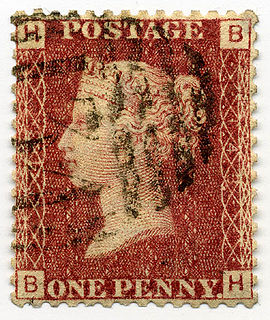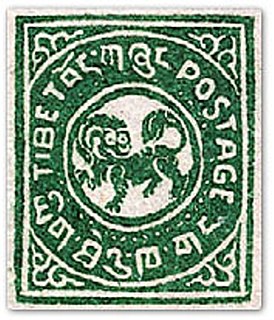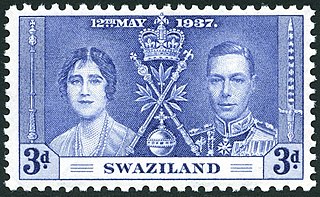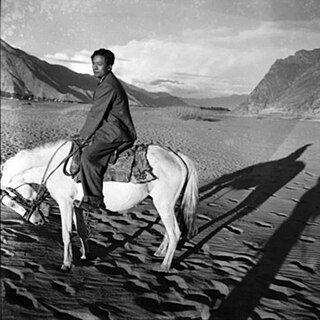Related Research Articles

Philately is the study of postage stamps and postal history. It also refers to the collection, appreciation and research activities on stamps and other philatelic products. Philately involves more than just stamp collecting or the study of postage; it is possible to be a philatelist without owning any stamps. For instance, the stamps being studied may be very rare or reside only in museums.

Stamp collecting is the collecting of postage stamps and related objects. It is an area of philately, which is the study or study and collection of stamps. It has been one of the world's most popular hobbies since the late nineteenth century with the rapid growth of the postal service, as a never-ending stream of new stamps was produced by countries that sought to advertise their distinctiveness through their stamps.

A postmark is a postal marking made on an envelope, parcel, postcard or the like, indicating the place, date and time that the item was delivered into the care of a postal service, or sometimes indicating where and when received or in transit. Modern postmarks are often applied simultaneously with the cancellation or killer that marks postage stamps as having been used. Sometimes a postmark alone is used to cancel stamps, and the two terms are often used interchangeably. Postmarks may be applied by handstamp or machine, using methods such as rollers or inkjets, while digital postmarks are a recent innovation.

Philatelic literature is written material relating to philately, primarily information about postage stamps and postal history.

Indian postal systems for efficient military and governmental communications had developed long before the arrival of Europeans. When the Portuguese, Dutch, French, Danish and British conquered the Marathas who had already defeated the Mughals, their postal systems existed alongside those of many somewhat independent states. The British East India Company gradually annexed the other powers on the sub-continent and brought into existence a British administrative system over most of modern-day India, with a need to establish and maintain both official and commercial mail systems.

Postage stamps and postal history of Great Britain surveys postal history from the United Kingdom and the postage stamps issued by that country and its various historical territories until the present day.

A personalized stamp is a postage stamp or rubber stamp or dry stamp, with an adjoining label on the left, on which, for a fee, an image and/or text of the purchaser's choosing may be placed. The stamps vary from country to country, and while some are normal stamps with a personalised label on the left attached by perforations, elsewhere the stamps are more properly regarded as one-piece personalized meter stamps with a colourful design next to the indicia. Stamps produced by Zazzle.com for the United States, for instance, are one-piece, self-adhesive with die cut margins to emulate perforations, and visually very similar to normal United States postage stamps, except for the addition of an IBI along one edge. Also, a numeric serial number appears next to IBI. Also produced in rubber by personalizedstamp.com around the world with creative designs for different purposes.

India Post is a government operated postal system in India, which is under the jurisdiction of Department of Post, Ministry of Communications of the Government of India. Generally called "the Post Office" in India, it is the most widely distributed postal system in the world. Warren Hastings had taken initiative under East India Company to start the Postal Service in the country in 1766. It was initially established under the name "Company Mail". It was later modified into a service under the Crown in 1854 by Lord Dalhousie. Dalhousie introduced uniform postage rates and helped to pass the India Post Office Act 1854 which significantly improved upon 1837 Post Office act which had introduced regular post offices in India. It created the position Director General of Post for the whole country.

The Digital Himalaya project was established in December 2000 by Mark Turin, Alan Macfarlane, Sara Shneiderman, and Sarah Harrison. The project's principal goal is to collect and preserve historical multimedia materials relating to the Himalaya, such as photographs, recordings, and journals, and make those resources available over the internet and offline, on external storage media. The project team have digitized older ethnographic collections and data sets that were deteriorating in their analogue formats, so as to protect them from deterioration and make them available and accessible to originating communities in the Himalayan region and a global community of scholars.

The postage stamps and postal history of Israel is a survey of the postage stamps issued by the state of Israel, and its postal history, since independence was proclaimed on May 14, 1948. The first postage stamps were issued two days later on May 16, 1948. Pre-1948 postal history is discussed in postage stamps and postal history of Palestine.

This is a survey of the postage stamps and postal history of Tibet.

This is a survey of the postage stamps and postal history of Nepal. Nepal has issued postal stamps since 1881.

The first postage stamps of Bhutan were issued in 1962, the same year that the first motorable road was opened. Before that there was a mail delivery system in place for official mail using mail runners, and between 1955 and 1962 revenue stamps were accepted as payment for internal mail. With the opening up of Bhutan in the early 1960s, a formal postal system was introduced. The American entrepreneur Burt Todd assisted in establishing a postage stamp program in the country and Bhutan became known for the unusual designs and materials of its stamps which were chosen by Todd specifically to attract attention. With the assistance of the Indian postal advisor Dr. K. Ramamurti, who was in Bhutan from 1964 to 1968, a proper postal organization and infrastructure was set up under the leadership of a young Bhutanese officer Mr. Lam Penjor, who became the Director of the Department of Posts and Telegraphs.

The Mosely Collection of British Africa stamps dating to 1935 was formed by Dr Edward Mosely of Johannesburg, South Africa. The collection was donated to the British Museum by his daughter, Kathleen Cunningham, in 1946 and is now held as part of the British Library Philatelic Collections. After the Tapling Collection, this is considered the Library's most important philatelic acquisition due to the number of countries represented and the number of unique items included.

Wolfgang C. Hellrigl was an expert on the philately of Nepal and Tibet who in 1994 was invited to sign the Roll of Distinguished Philatelists.
Lionel Edward Dawson (1887–1976) was a philatelist who won the Crawford Medal from the Royal Philatelic Society London for his paper on The One Anna and Two Annas Postage Stamps of India, 1854-55. He was an expert on the stamps of India and the Feudatory States and signed the Roll of Distinguished Philatelists in 1961.

This is a survey of the postage stamps and postal history of Eswatini, formerly Swaziland.

Pratek Man Tuladhar (1924–1991) was a Nepalese trader and philatelist. Born in Kathmandu into a family of hereditary merchants, he spent his youth in Lhasa, Tibet, where they owned a business house.
Philip Thomas Saunders FRPSL was a British banker and philatelist. He started in banking before the First World War but his career was interrupted by service in the Royal Flying Corps during the conflict. Returning to banking after the war, he published a history of Stuckey's Bank in 1928, working for banks that ultimately became today's National Westminster, before retiring in 1959.

Everard Francis Aguilar was a Jamaican horticulturist, stamp dealer, and philatelist.
References
- ↑ Home page, Nepal and Tibet Philatelic Study Circle, 2012. Retrieved 11 March 2012.
- ↑ Postal Himal, no. 147, 3rd Quarter 2011, p.4, himalaya.socanth.cam.ac.uk/collections/journals/postalhimal/pdf/PH_2011_003.pdf
- ↑ Introduction to the NTPSC quarterly on Digital Himalaya http://www.digitalhimalaya.com/collections/journals/postalhimal/
- ↑ "Digital Himalaya: Postal Himal".
- ↑ "Welcome to the Home Page of the NTPSC".